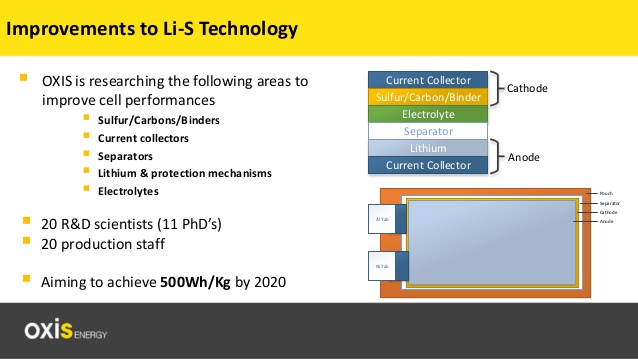Diane Simard, Senior Vice President and a member of the Board of Directors for Bye Aerospace, sends your editor occasional news from that company. The latest involves a collaboration with OXIS Energy in England to develop new Lithium-Sulfur battery cell technology that shows great, and (even better) near-term promise. Ready to start in September, the project will develop cells that will, ”Achieve the higher energy density required for such aircraft,” referring to Bye’s eFlyer 2 and eFlyer 4 light aircraft. A big jump over currently available batteries, OXIS is now evaluating cells that produce 400 Watt-hours per kilogram, with a promised leap to 500 kW-hr by next year. The best lithium-ion cells at the pack level available now manage 260 W-hr/kg. Huw W. Hampson-Jones, CEO of OXIS Energy, discusses his company’s unique approach to battery development and what this portends for future flight and general electric mobility. Explaining OXIS’s applications, he adds, “Aviation is one of OXIS’ target markets, and …
UAVOS Flies ApusDuo HAPS
UAVOS, located in the midst of surrounding Google properties in Mountain View, California, sells a wide variety of goods and services related to the unpiloted aircraft world. One of their biggest creations so far, the ApusDuo High Altitude Psuedo Satellite (HAPS) ran through a full series of tests. The 10-meter span prototype vehicle will test control algorithms, including takeoffs and landings and verify HAPS aerodynamics. According to UAVOS “Test flights fully confirmed the flight characteristics of the UAV.” This is good news, since their next step will be to make at least a 15-meter wing (49.2 feet) wingspan version. That will rely even more on “Control of roll, pitch, v-shape and slip…due to a controlled change in the angle of attack in particular sections of the wings” employed by the designers. Note the flexibility of the entire airframe during launch and flight. These controls include the visibly tricky interactions of the two slender wings, a rare pair in tandem designed …
Zephyr Breaks Its Own Record – Again
The Royal Aeronautical Society, official record keeper for such things, announced in an August 8 press release, “Taking off from Arizona, US on 11 July, Airbus Defense’s solar-powered UAV (unpiloted aerial vehicle), the British-built Zephyr S, has smashed the existing endurance record for unrefueled, unmanned flight by staying aloft for 25 days, 23 hours and 57 minutes. This, the maiden flight of the production Zephyr S HAPS (high altitude pseudo satellite) for the UK MoD (United Kingdom Ministry of Defense), once verified, almost doubles the existing endurance flight record of 14 days, 22 minutes for UAVs, set by a previous Zephyr prototype in 2010. The solar-powered Zephyr UAV, which weighs less than 75 [kilograms – 165 pounds], flies at 70,000ft, above air traffic and weather, to provide a new class of platform for persistent surveillance, observation, communications relay or connectivity for military or commercial customers. Airbus said that the maiden flight saw test objectives met with further flights planned in …
Sion Power, Airbus, UAE Team Up to Set Dubai Altitude Record
First, let’s get the new acronym out of the way. The solar-powered flyer recently setting records in Dubai is part of the Airbus High Altitude Pseudo-Satellite (HAPS) program. One headline led off with “What’s the HAPS?” leaving your editor saddened by not having thought of it first. Such craft were previously referred to as HALEs (High Altitude Long Endurance) platforms. It’s also part of the Emirates Institution for Advanced Science and Technology (EIAST), a kind of Middle-Eastern STEM program promoting technological advancement and sustainable development in Dubai and the United Arab Emirates (UAE). The airplane set three world records in 2010, flying over the desert Southwest in America as part of Qinetiq’s development program. It managed 336 hours 22 minutes and 8 seconds then, but has added a record 61,696 feet altitude to its accomplishments during a 23 hour, 47 minute flight over Dubai, the highest flight so far in the UAE. Gizmag noted the flight was the first time …



